Assessing Outdoor Air Near Schools
Clairton Educational Center - Clairton, PA and South Allegheny Middle/High School - McKeesport, PA
- Understanding the Monitoring Data
- Initial Sample Results
- Initial Analysis
- Additional Sample Results
- Final Analysis
Results and Analysis of EPA’s monitoring
EPA selected these schools for monitoring because they are located near a coke oven and a coke by-product facility, which converts the coke oven tars to other products, both of which are sources of air toxics emissions. Computer models were used to determine which air toxics may be present at elevated levels in the outdoor air near these schools. These models showed that pollutants associated with coke oven operations, including benzene, arsenic, and benzo(a)pyrene, could be present in the air around the schools and prompted EPA to test to see if the levels present may be of concern.
| Primary Findings | At South Allegheny Middle and High School, while the concentrations of the arsenic and benzo(a)pyrene are individually below long-term comparison levels (as shown below), the benzene concentrations and concentrations of some other source-related pollutants are near or above their long-term comparison levels. The complete analyses of these data indicate the potential for levels of concern for long-term, continuous exposure to benzene individually, and to the mixture of these pollutants in areas of this neighborhood. Levels of these pollutants at Clairton Educational Center, while indicating influence of the coke-related sources, are below the levels of significant concern that had been suggested by the modeling information available prior to sampling. |
| Key Pollutants Monitored | Benzene. Inhalation of benzene at high levels can affect the bone marrow and can cause anemia and leukemia. |
| Next Steps | Based on the analysis described here, EPA recommends additional monitoring at South Allegheny Middle/High School for the coke oven pollutants to better characterize the potential for exposures of concern in the neighborhood from the coke oven and coke by-product facilities. EPA remains concerned about emissions from sources of air toxics and continues to work to reduce those emissions across the country, through national rules and by providing information and suggestions to assist with reductions in local areas. The area surrounding both of these schools (the Liberty-Clairton area of Allegheny County) is currently not meeting national ambient air quality standards (NAAQS) for fine particles (particulate matter less than 2.5 microns in size) which can contain some of the pollutants monitored. The Allegheny County Health Department (ACHD) has submitted a state implementation plan which details how the area will be brought back into attainment with the NAAQS. The ACHD will continue to oversee industrial facilities in the area through air permits and other programs. |
Summary of Study Approach and Findings
Approach:
- A monitor collected air samples from September 4, 2009 through December 21, 2009 at Clairton Educational Center and from August 5, 2009 through November 30, 2009 at South Allegheny Middle/High School, both schools located in McKeesport, PA.
- We posted individual air sample results on the websites for these schools (Clairton Educational Center and South Allegheny Middle/High School) throughout the monitoring period to keep your community informed during the monitoring period.
- During the monitoring period, we evaluated the monitored concentrations to see if there was a concern from short-term exposures (e.g., several weeks).
- When the monitoring was complete, we analyzed the results to see if there was a concern from long-term exposures (over a lifetime).
- Also, when the monitoring was complete, we evaluated all the air samples from the on-site monitors. We also evaluated information on wind speed and wind direction from a weather monitor at each of the schools, along with historical weather information and information about nearby sources of benzene, arsenic, and benzo(a)pyrene emissions.
Findings:
- Our analysis found that at South Allegheny Middle and High School, while the concentrations of the arsenic and benzo(a)pyrene are individually below long-term comparison levels (as shown below), the benzene concentrations and concentrations of some other source-related pollutants are near or above their long-term comparison levels. The complete analyses of these data indicate the potential for levels of concern for long-term, continuous exposure to benzene individually, and to the mixture of these pollutants in areas of the neighborhood.
- Levels of these pollutants at Clairton Educational Center, while indicating some influence of the coke-related sources, are below the levels of health concern that had been suggested by the modeling information available prior to sampling.
- The process to identify schools for monitoring relied on emissions estimates and other information. Ambient air monitoring at the school allowed measurement of what was actually in the air.
- Information from the nearby coke oven source indicates this facility was operating below normal production levels, and the coke by-product facility was also operating below normal production levels.
- EPA recommends additional monitoring at South Allegheny Middle/High School to better characterize the potential for exposures of concern in the neighborhood.
- Click here for additional information
How We Analyzed the Information We Collected at these Schools
The analysis considered whether the information collected at these schools might raise concerns for the health of children or adults at these schools. We looked at the following types of information:
- Measured benzene, arsenic, and benzo(a)pyreneconcentrations and information on benzene, arsenic, and benzo(a)pyrene
- Measured wind direction and wind speed at these schools
- Information about nearby sources of benzene, arsenic, and benzo(a)pyrene emissions
Analysis of Measured Concentrations:
At South Allegheny Middle and High School, although the concentrations of the arsenic and benzo(a)pyrene are individually below long-term comparison levels (as shown below), the benzene concentrations and concentrations of some other source-related pollutants are near or above their long-term comparison levels. The complete analyses of these data indicate the potential for levels of concern for long-term, continuous exposure to benzene individually, and to the mixture of these pollutants in areas of this neighborhood.
Analysis of the levels of the monitored pollutants at Clairton Educational Center, while indicating an influence of the coke-related sources, are below the levels of health concern that had been suggested by the modeling information available prior to sampling.
1a. Calculate the benzene average: We calculated the averages of the benzene measurements (shown by the black diamond in the graph below). We compared these averages to the long-term comparison levels (see thick line on the graph below).
Result: The average benzene levels for the samples collected at Clairton Educational Center and South Allegheny Middle/High School were below the long-term comparison levels.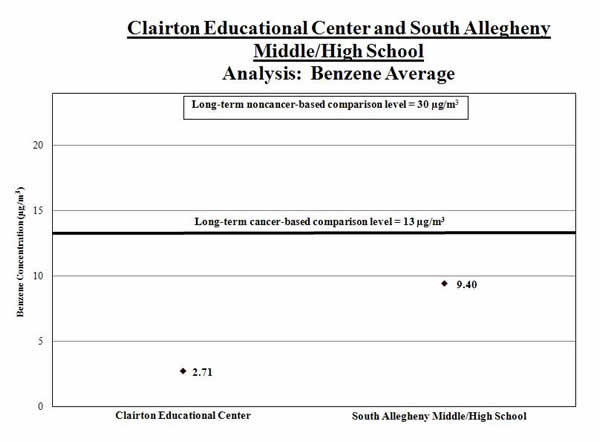
1b. Calculate a range for the benzene average: To account for varying air concentrations of benzene, we calculated ranges around the averages. We did this by estimating high and low values that the longer-term concentrations might reach using common statistical tools. We compared the highest points in the ranges (called the “upper bounds”) to the long-term comparison levels.
Result: The high end of the range for South Allegheny Middle/High School is higher than the lower comparison level. There is a potential for levels of health concern for long-term continuous exposure in this community. At Clairton Educational Center, the high end of the benzene range is below the long-term comparison levels.
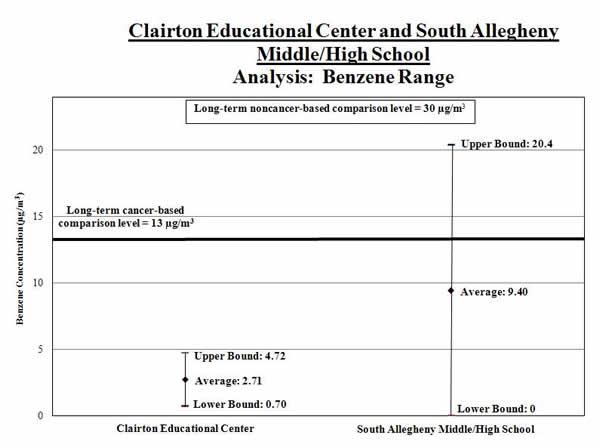
2a. Calculate the arsenic average: We calculated the averages of the arsenic measurements (shown by the black diamond in the graph below). We compared these averages to the long-term comparison levels (see thick line on the graph below).
Result: The average arsenic levels for the samples collected at Clairton Educational Center and South Allegheny Middle/High School were below the long-term comparison levels.
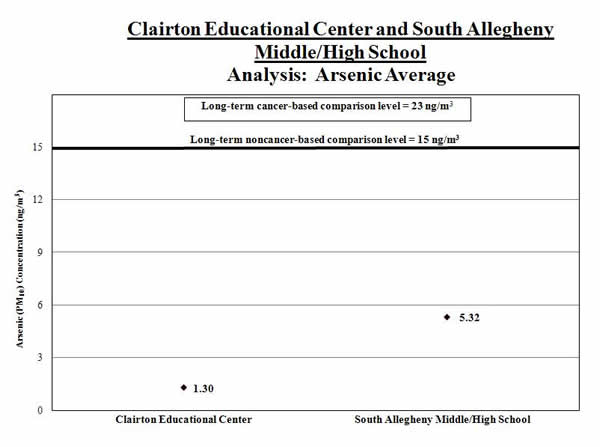
2b. Calculate a range for the arsenic average: To account for varying air concentrations of arsenic, we calculated ranges around the averages. We did this by estimating high and low values that the longer-term concentrations might reach using common statistical tools. We compared the highest points in the ranges (called the “upper bounds”) to the long-term comparison levels.
Result: The high ends of the ranges for the samples collected at Clairton Educational Center and South Allegheny Middle/High School are lower than the comparison levels.
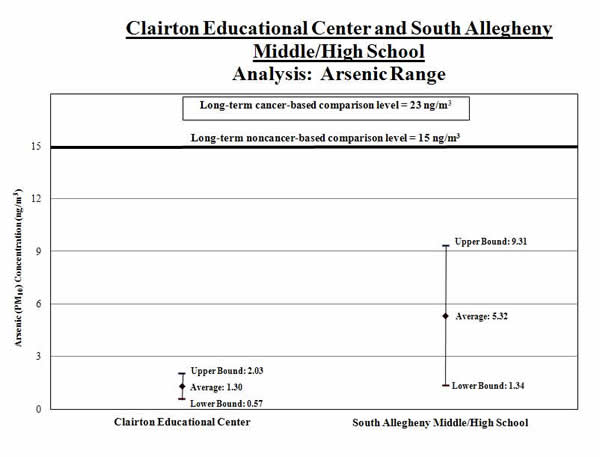
3a. Calculate the benzo(a)pyrene average:We calculated the averages of the benzo(a)pyrene measurements (shown by the black diamond in the graph below). We compared these averages to the long-term comparison levels (see thick line on the graph below).
Result: The average benzo(a)pyrene levels for the samples collected at Clairton Educational Center and South Allegheny Middle/High School were well below the long-term comparison levels.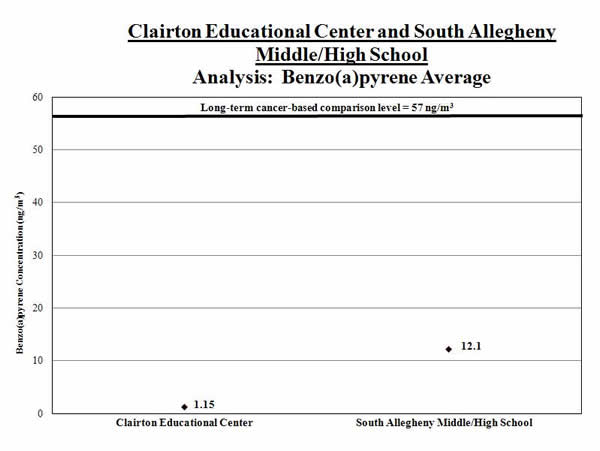
3b. Calculate a range for the benzo(a)pyrene average: To account for varying air concentrations of benzo(a)pyrene, we calculated ranges around the averages. We did this by estimating high and low values that the longer-term concentrations might reach using common statistical tools. We compared the highest points in the ranges (called the “upper bounds”) to the long-term comparison levels.
Result: The high ends of the ranges for the samples collected at Clairton Educational Center and South Allegheny Middle/High School are lower than the comparison levels.
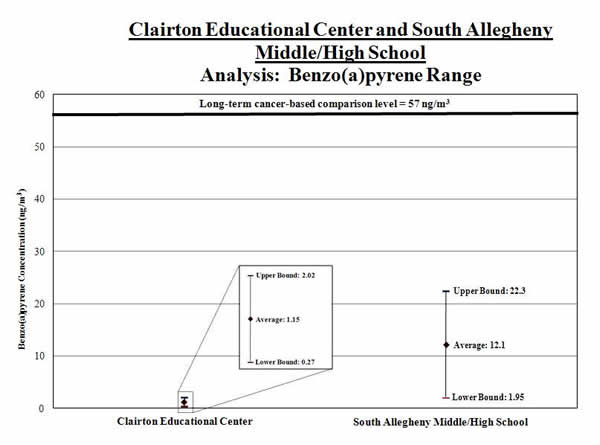
Analysis of Measured Wind Direction and Wind Speed at Each School
We took measurements of wind direction and speed every day during the sample period. We took special note of the wind speed and direction on the days we took measurements of benzene, arsenic, and benzo(a)pyrene.
| What we looked at | What we found |
We looked at whether the wind data taken on the days we took measurements of benzene, arsenic, and benzo(a)pyrene are similar or different from the wind patterns during the entire sampling period. |
We found the wind patterns taken on the days we took measurements of benzene, arsenic, and benzo(a)pyrene to be generally similar to those observed during the entire sampling period. |
We looked at whether the wind pattern during the sampling period is reflective of regional wind pattern over the long term. |
The wind pattern at the monitoring station at South Allegheny Middle/High School during the sampling period is generally similar to the historical long-term wind flow pattern at that same school. This suggests that, on a regional scale, the 5-month sampling period may be representative of year-round wind patterns. Although we lack long-term wind data at Clairton Educational Center, the wind pattern at this school station during the sampling period is not similar to the historical long-term wind flow pattern at the South Allegheny Middle/High School station. However, this is likely due to differences created by the Monongahela River and terrain around the river. |
Analysis of Information on Nearby Sources of Benzene, Arsenic, and Benzo(a)pyrene Emissions
| What we looked at | What we found |
Whether we could determine if the sources were operating as usual during the sampling period. |
Information from the nearby coke oven source indicates that this facility was operating at a rate of about 65% of normal capacity during the sampling period. This takes into account the fact that several batteries were permanently shut down in spring 2009. Information from the nearby coke by-product facility indicates that this facility was operating at 32% capacity during the sampling period, down from previous years. In 2010, capacity was up to 67% and closer to operations in years previous to the economic downturn in 2009. |
At South Allegheny Middle/High School, concentrations of the pollutants associated with coke oven emissions, including benzene, arsenic, and benzo(a)pyrene, are as high as was indicated by modeling information available prior to sampling. At Clairton Educational Center, concentrations of the pollutants associated with coke oven emissions are lower than those that had been suggested by the modeling information available prior to sampling. |
|
| The nearby sources of benzene, arsenic, and benzo(a)pyrene have Title V operating air permits issued by ACHD that includes operating requirements. |
Additional Information
Technical Report for School: Assessing Outdoor Air Near Schools: Clairton Educational Center (Clairton, PA) and South Allegheny Middle/High School (McKeesport, PA) (PDF) (47pp, 786k). The technical report is geared toward risk assessors, risk managers, and other regulatory agencies.
Background on School Monitoring Effort
General Questions and Answers for School Monitoring Effort
